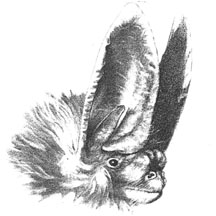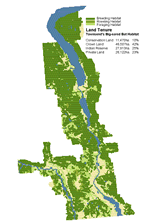|
Habitat Atlas for Wildlife at Risk
Townsend's Big-eared Bat
Corynorhinus townsendii

Townsend's
Big-eared Bat
|

- Total length: 10 cm; wingspan: 29 cm.
- Huge ears: 3-4 cm long (about one half of the
body length!)
- Weight: 9 grams.
- Long dorsal fur varies from pale brown to blackish-grey;
underfur is paler.
- Two prominent glandular swellings on its nose.
Status:
British Columbia Blue List
Special Significance
Townsend's Big-eared Bats are at risk in British Columbia
because of their small provincial population size,
vulnerability to disturbance and low reproductive
rate. Because of their extreme sensitivity to human
contact, they should be left undisturbed when roosting
or hibernating. Conservation of riparian areas, which
support a diversity of insects, is an important factor
in helping to ensure the continued survival of most
bat species.
Distribution
- In British Columbia, Townsend's Big-eared Bats have been found
from Vancouver Island east to Cranbrook, and north to Williams Lake.
In
the interior, most records of this bat are from
the Okanagan, Shuswap, Kamloops, Williams Lake and Kootenay areas.
- Prefers regions that are relatively warm and dry in
the summer, and not extremely cold in winter, including
the Coastal Douglas Fir, Bunchgrass, Ponderosa Pine and Interior
Douglas Fir zones.
Habitat
- Dry grasslands, coniferous and deciduous forests.
- Foraging habitat includes insect-rich riparian areas,
wetlands, forest edges and open woodland.
- Summer day and night roosts include caves, old mines
and buildings; these locations are also suitable
hibernating sites.
- Dependent on close proximity of roosting and foraging
sites.
- Summer maternity colonies and hibernation sites are
usually within few kilometres.
Reproduction
- Hibernation occurs from September to May.
- Mating takes place from November to February, usually
at hibernation sites.
- Sperm is stored all winter in the female reproductive
tract, a strategy called delayed fertilization;
ovulation and fertilization occurs in spring.
- In spring, females form summer maternity colonies,
usually returning to the same site each year;
males roost singly at night in scattered locations.
- Gestation period is controlled by temperature and
varies from 50 to 100 days; cool temperatures
induce torpor (a lowering of
body temperature and metabolic rate).
- Female bats give birth to one young per year in late
June to mid July.
- Young grow extremely fast and begin to fly at 2.5
to 3 weeks of age and are weaned at about 6
weeks.
Food Habits
- Bats begin foraging an hour or so after dark and feed several
times throughout the night.
- Diet consists of small moths, flies, beetles, lacewings
and sawflies.
- Prey is gleaned by these agile bats from foliage of
trees and shrubs, although most insects are captured
in the air.
Interesting Facts
- A Townsend's Big-eared Bat's average lifespan is 16 years; bats
may live up to 30 years.
- Highly maneuverable flyer; capable of flying at slow
hovering speeds.
- Large ears funnel sound into ear canal, and may also
provide lift during flight and assist with temperature
regulation.
- Distinctive fleshy protrusions on sides of nose may
function as sexual scent glands.
- One of the few bat species known to consistently
overwinter in British Columbia.
- By the end of hibernation, a bat may lose more than
half of its autumn weight.
Threats
- Extensive land development in the Okanagan has
eliminated or fragmented their habitat
(low elevation forest, grassland and riparian areas).
- Their low reproductive rate means a slow recovery
rate after disturbances.
- Nursery roosts are extremely sensitive to human
disturbance; females may permanently abandon
a traditional summer roost.
- Disturbance at winter hibernating sites can cause
energy loss, abandonment of the site and
death.
- Sealing mine shafts reduces opportunities for summer
roosting and winter hibernation.
Management Considerations
- Avoid the use of pesticides, particularly near
wetlands and riparian areas.
- Protect key habitat such as forest, grassland,
wetlands and riparian areas.
- Preserve old mine shafts at key sites but erect
gates to prevent human access.
- Refrain from entering caves or mine shafts, particularly
during winter months when bats are hibernating.
- Contact your local British Columbia Ministry
of Water, Land and Air Protection to report
roosting or hibernation sites.
|
References
1. Ministry of Water, Land and Air Protection. 1998. Species at risk
brochure: Townsend's Big-eared Bat. Ministry of Water, Land and Air
Protection, Victoria, British Columbia
2. Nagorsen, D.W. and R.M. Brigham. 1993. Bats of British
Columbia. Royal British Columbia Museum Handbook, Victoria, British
Columbia
|